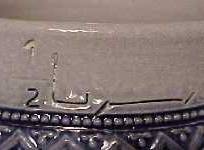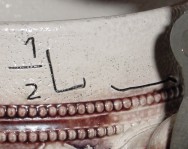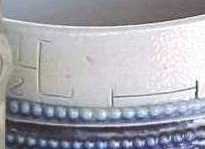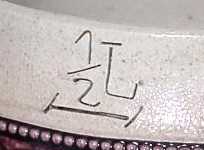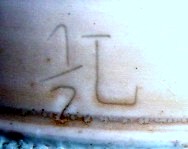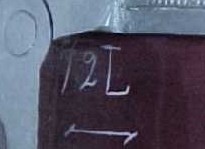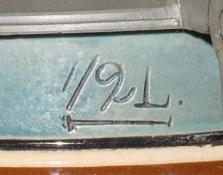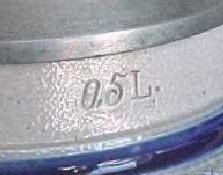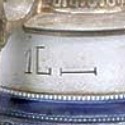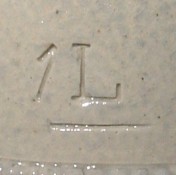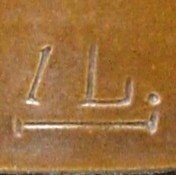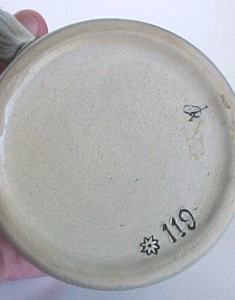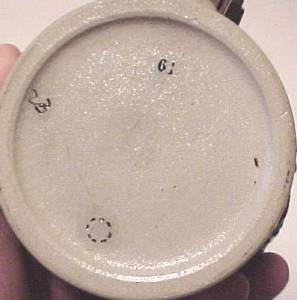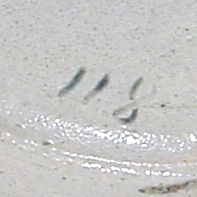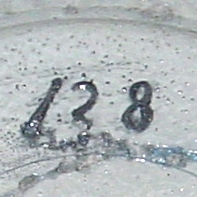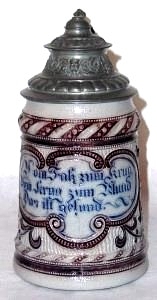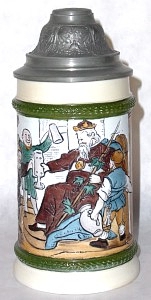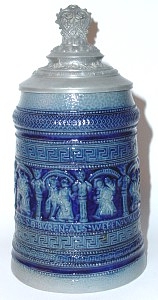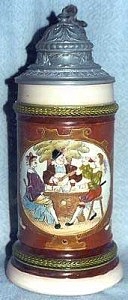The Freising/HR capacity marks: The six marks in the first two rows above were used in the Freising factory itself. The two on the upper left were used prior to the factory becoming HR. The two additional marks on the third line were used on HR steins made outside the Freising factory. The mark on the left is that of the Merkelbach & Wick factory and that on the right the mark of the Gerz factory. In addition to the marks above, there are four 1 liter capacity marks that you should be aware of, and while the "type 11" is seen on a fairly regular basis, the "type 9," "type 9b" and "type 10" border on rare. The "type 9" is found on pre-HR steinzeug made in Freising (1876-1882), the "type 9b" is found on HR steinzeug made in Freising (1882-1886), the "type 10" is found on HR steinzeug steins manufactured by Gerz (1886) and the "type 11" is found on HR ivory-stoneware steins manufactured by Merkelbach & Wick (1887-ca.1907).
~~~~~~~ We don't know the true purpose of the next two groups of marks, but the simple fact that they exist has been a windfall. Through these marks, and the capacity marks above, we have been able to tie HR stoneware steins to the Freising factory. These are but a sample of those seen so far. There are approximately a dozen of each known, giving us a possiblity of at least 144 different combinations. ~~~~~~~ For the sake of discussion I've called these geometric, or pictorial, stamps Quality Control (Q.C.) marks. These are a few of those used and the most common I've seen is the one on the left that looks like an Edelweiss. These stamps were applied while the clay was still damp and were used from 1876 to 1886. ~~~~~~~ The Decorator's Initial, for lack of a better term, is a scratched in initial that may belong to the person who decorated the piece. Of those seen so far the "K," "b," "L," and what looks like a "Jc," probably a sloppy "M," are the most common. It is quite possible that the decorators were paid by the piece and these initials were tally marks. The initials were scratched in after the clay had dried and were used from 1876 to 1886. ~~~~~~~ CONTINUITY OF DECORATOR'S INITIALS This chart shows that four employees placed their initials on the bases of steins manufactured in both the Hauber period and the Hauber & Reuther period. At least three of those employees were putting their marks on the steins throughout the entire 1876-1886 stoneware production period. This is another example that definitely ties HR stoneware production to the Freising factory.
~~~~~~~
Two distinctly different model numbers were used at the Freising factory. On the left you see the large font model number (10 mm) that was used only in 1876 and on the right the small font model number (5 mm) that was used from 1876 to 1886. Note also the quality control marks and the decorator's initials that are typical of all Freising steins manufactured between 1876 and 1886. ~~~~~~~
From time to time you might encounter a stein that has a hand etched model number, quality control mark and/or HR logo. There could be any number of reasons for this, some have suggested they might be prototypes, but I think the reason is simply that wherever the steins were to receive their marks, they were somehow overlooked and when the omission was later discovered, perhaps by the decorator, the marks were added by hand. There is also a possibility that for a short period in late 1876, the factory was without a stamp set causing them to hand apply the model numbers. ~~~~~~~ Trying to assign Freising/HR steins to catagories based on model (mold) number is an uncertain thing at best. I don't use the term "mold number" because HR steins from the same mold can have different model numbers, and steins from different molds and of different materials, can have the same model number. Add to that the fact that three other factories produced steins for HR and you have the makings for a very confused situation. Apparently, if a particular model was dropped from the product line, that model number could be reinstated later, on a completely different stein.
Above are two examples. All of these steins were manufactured in Freising. The stein on the left is a blue, purple and grey stoneware piece, that was discontinued and replaced by the stein on the right, a porcelain stein. There are other model number duplications but they are rare. I know of at least 30 duplicated model numbers and most are either on a porcelain, or ivory stoneware stein replacing a no longer manufactured blue and grey stoneware stein of a different design. Remember, the only thing that really changed in 1882 was that Albert Hauber took on a new partner, Hans Reuther. Except for the addition of the HR logo, and the introduction of custom ordered hand painted scenes, there was little change to the product line before 1886. Model number, or mold number, whichever you prefer to call them, don't place too much significance on their meaning. As we will see later, it is also impossible to determine the manufacturing sequence from the model (mold) numbers. |
